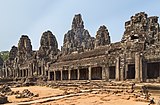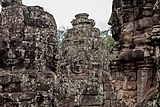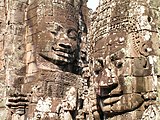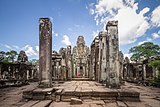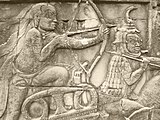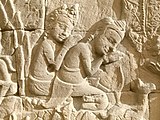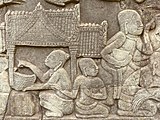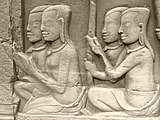Bayon

The Bayon (Khmer: ប្រាសាទបាយ័ន, Prasat Bayoăn [praːsaːt baːjŏən]) is a richly decorated Khmer temple related to Buddhism at Angkor in Cambodia. Built in the late 12th or early 13th century as the state temple of the King Jayavarman VII (Khmer: ព្រះបាទជ័យវរ្ម័នទី ៧), the Bayon stands at the centre of Jayavarman's capital, Angkor Thom (Khmer: អង្គរធំ).[1][2]
The Bayon's most distinctive feature is the multitude of serene and smiling stone faces of The Buddha - probably modeled on the face of King Jayavarman VII - on every side the many towers that jut out from the upper terrace and cluster around its central peak.[3] The main conservatory body, the Japanese Government Team for the Safeguarding of Angkor (the JSA) has described the temple as "the most striking expression of the baroque style" of Khmer architecture, as contrasted with the classical style of Angkor Wat (Khmer: ប្រាសាទអង្គរវត្ត).[4]
Etymology
The original name for the Bayon is Jayagiri (Khmer: ជ័យគីរី, Chey Kĭri) (or "Victory Mountain" or “Mountain of Brahma” ; “Jaya” - another name of Brahma and “giri” to mountain), with Sanskrit roots similar to Sīnhāgiri ("Lion Rock"). [citation needed]
The name of Bayon was given by Etienne Aymonier in 1880. According to his report, Bayon was the Latin transliteration of what he had seen written in Khmer as "Bayânt" which he presumed most have been a corrupted form of the Pali Vejayant or Sanskrit Vaijayant, the name of the celestial palace of Indra of which the Bayon was presumed to be the earthly reflection. The first syllable Ba as a Sanskritic prefix was similar to that found in other places such as Ba Phnom and could signify the presence of a protector or defensor.[5]
History

Buddhist symbolism in the foundation of the temple by King Jayavarman VII

| Part of a series on |
| Buddhism |
|---|
 |
The Bayon was the last state temple to be built at Angkor (Khmer: ក្រុងអង្គរ), and the only Angkorian state temple to be built primarily to worship buddhist deities, though a great number of minor and local deities were also encompassed as representatives of the various districts and cities of the realm. Originally a Hindu temple, the Bayon(Jayagiri) was the centrepiece of Jayavarman VII's massive program of monumental construction and public works, which was also responsible for the walls and nāga-bridges of Angkor Thom (Khmer: អង្គរធំ) and the temples of Lord Vishnu (Khmer: ប្រាសាទព្រះខ័ន), Ta Prohm (Khmer: ប្រាសាទតាព្រហ្ម) and Banteay Kdei (Khmer: ប្រាសាទបន្ទាយក្តី).[7]

The similarity of the 216 gigantic faces on the temple's towers to other statues of the has led many scholars to the conclusion that the faces are representations of Jayavarman VII, himself (
Alterations following the death of Jayavarman VII
| Part of a series on |
| Hinduism |
|---|
 |
Since the time of
Modern restoration
In the first part of the 20th century, the
The site

The temple is oriented towards the east, and so its buildings are set back to the west inside enclosures elongated along the east-west axis. Because the temple sits at the exact centre of
The outer gallery: historical events and everyday life
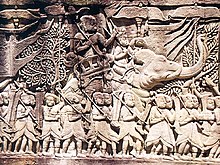
The outer wall of the outer gallery features a series of
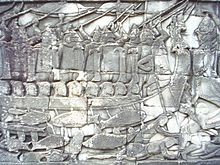
- in the southern part of the eastern gallery a marching Khmer army (including some Chinese soldiers),[12] with musicians, horsemen, and officers mounted on elephants, followed by wagons of provisions;
- still in the eastern gallery, on the other side of the doorway leading into the courtyard, another procession followed by domestic scenes depicting Angkorian houses, some of the occupants of which appear to be Chinese merchants;
- in the southeast corner pavilion, an unfinished temple scene with towers, : លិង្គសិវៈ);
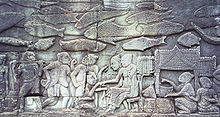
- in the eastern part of the southern gallery, a naval battle on the underneath which are more scenes from civilian life depicting a market, open-air cooking, hunters, and women tending to children and an invalid;
- still in the southern gallery, past the doorway leading to the courtyard, a scene with boats and fisherman, including a Chinese junk, below which is a depiction of a cockfight; then some palace scenes with princesses, servants, people engaged in conversations and games, wrestlers, and a wild boar fight; then a battle scene with Cham warriors disembarking from boats and engaging Khmer warriors whose bodies are protected by coiled ropes, followed by a scene in which the Khmer dominate the combat, followed by a scene in which the Khmer king celebrates a victory feast with his subjects;
- in the western part of the southern gallery, a military procession including both Khmers and Chams, elephants, war machines such as a large crossbow and a catapult;
- in the southern part of the western gallery, unfinished reliefs show an army marching through the forest, then arguments and fighting between groups of Khmers;[15]
- in the western gallery, past the doorway to the courtyard, a scene depicting a melee between Khmer warriors, then a scene in which warriors pursue others past a pool in which an enormous fish swallows a small deer;[16] then a royal procession, with the king standing on an elephant, preceded by the ark of the sacred flame;
- in the western part of the northern gallery, again unfinished, a scene of royal entertainment including athletes, jugglers and acrobats, a procession of animals, ascetics sitting in a forest, and more battles between Khmer and Cham forces;
- in the northern gallery, past the doorway to the courtyard, a scene in which the Khmer flee from Cham soldiers advancing in tight ranks;
- in the northeast corner pavilion, another marching Khmer army;
- in the eastern gallery, a land battle between Khmer and Cham forces, both of which are supported by elephants: the Khmer appear to be winning.
The outer gallery encloses a courtyard in which there are two libraries (one on either side of the east entrance). Originally the courtyard contained 16 chapels, but these were subsequently demolished by the Hindu restorationist Jayavarman VIII.
The inner gallery: depictions of mythological events
The inner gallery is raised above ground level and has doubled corners, with the original redented cross-shape later filled out to a square. Its bas-reliefs, later additions of Jayavarman VIII, are in stark contrast to those of the outer: rather than set-piece battles and processions, the smaller canvases offered by the inner gallery are decorated for the most part with scenes from

The upper terrace: 200 faces of Lokesvara
The inner gallery is nearly filled by the upper terrace, raised one level higher again. The lack of space between the inner gallery and the upper terrace has led scholars to conclude that the upper terrace did not figure in the original plan for the temple, but that it was added shortly thereafter following a change in design. Originally, it is believed, the Bayon had been designed as a single-level structure, similar in that respect to the roughly contemporaneous foundations at Ta Prohm and Banteay Kdei.[20]
The upper terrace is home to the famous "face towers" of the Bayon, each of which supports two, three or (most commonly) four gigantic smiling faces. In addition to the mass of the central tower, smaller towers are located along the inner gallery (at the corners and entrances), and on chapels on the upper terrace. "Wherever one wanders," writes
Efforts to read some significance into the numbers of towers and faces have run up against the circumstance that these numbers have not remained constant over time, as towers have been added through construction and lost to attrition. At one point, the temple was host to 49 such towers; now only 37 remain.[3] The number of faces is approximately 200, but since some are only partially preserved there can be no definitive count.
The central tower and sanctuary
Like the inner gallery, the central tower was originally cruciform but was later filled out and made circular. It rises 43 metres above the ground. At the time of the temple's foundation, the principal religious image was a statue of the
Gallery
See also
- Indosphere
- Greater India
- Hinduism in Southeast Asia
- Buddhism in Southeast Asia
- List of Hindu temples
- List of Buddhist temples
References
- ISBN 9781842125847, p.121
- ISBN 9786167339443
- ^ a b Freeman and Jacques, p.78.
- ^ The Bayon Symposium
- ^ Aymonier, Etienne (1880). Excursions et reconnaissances (in French). Saigon. p. 185.
{{cite book}}: CS1 maint: location missing publisher (link) - ^ a b c Glaize, p.87.
- ISBN 978-0-8248-0368-1.
- ^ Coedės, p.137.
- ^ Coedès, p.147.
- ^ Glaize, p.85.
- ^ See Glaize, pp.90 ff. and Rovedo, pp.134 ff., for detailed descriptions of the bas-reliefs.
- ^ Freeman and Jacques, p.85-86. The Khmer are depicted as having short hair and long earlobes, and as wearing loincloths and little else. The Chinese are identified by their beards, topknots, and patterned tunics.
- ISBN 978-0-8248-0368-1.
- ^ Freeman and Jacques, p.85-87. The Cham are identified by their tunics, curved shields, and distinctive crown and scarf headgear. It has been speculated that this scene represents the Cham naval attack on the Khmer capital in 1177. However, since the scene seems to have the Khmer winning, and since the Cham naval attack of 1177 was successful and led to the sack of the Khmer capital, it may be more accurate to say that the scene depicts a subsequent naval engagement from which the forces of Jayavarman VII emerged victorious.
- ^ Freeman and Jacques, pp.91-92. The subject-matter here may be a revolt documented to have occurred in 1182.
- ^ Glaize, p.92. Unlike most of the bas-reliefs, this one is accompanied by an inscription, albeit by one that is not particularly helpful. It says, "The deer is his nourishment."
- ^ Glaize, pp.94 ff.
- ^ Glaize, p.98; Rovedo, pp.148-149 (both preferring the former interpretation).
- ^ Freeman and Jacques, p.101; Rovedo, p.149-150 (speculating that the serpent is symbolic of the disease itself).
- ^ Coedès, p.127.
- ^ Glaize, p.89.
- ^ Freeman and Jacques, p.83; Glaize, p.87.
Bibliography
- Albanese, Marilia (2006). The Treasures of Angkor (Paperback). Vercelli: White Star Publishers. ISBN 88-544-0117-X.
- Coedès, George. Pour mieux comprendre Angkor (Hanoi: Imprimerie D'Extrême-Orient, 1943), esp. Ch.6, "Le mystère du Bayon," pp. 119–148.
- Freeman, Michael and Jacques, Claude. Ancient Angkor. River Books, 1999, pp. 78 ff. ISBN 0-8348-0426-3.
- Glaize, Maurice. The Monuments of the Angkor Group. Translated into English from the French, revised 1993 and published online at theangkorguide.com. (The link takes you directly to the section of this work having to do with Angkor Thom and the Bayon.)
- Jessup, Helen Ibbitson; Brukoff, Barry (2011). Temples of Cambodia - The Heart of Angkor (Hardback). Bangkok: River Books. ISBN 978-616-7339-10-8.
- Rovedo, Vittorio. Khmer Mythology: Secrets of Angkor (New York: Weatherhill, 1998), pp. 131 ff.
- JSA Bayon Master Plan Archived 2004-12-07 at the Wayback Machine Accessed 17 May 2005.
- JSA Bayon Symposia Accessed 17 May 2005.



